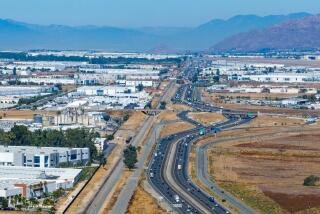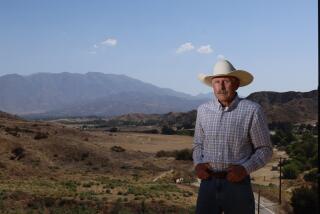‘Truck Town’ Plans Ahead : Castaic Growth Map to 2010 Tries to Dodge Problems of Its Sister Communities
- Share via
A plan that would guide development in Castaic until the year 2010 was generally supported at a public hearing Thursday, but some developers said the plan would unfairly limit building in rural canyons.
The plan, according to Los Angeles County planners, would drastically alter the economy of the tiny community by increasing the amount of industrial land more than tenfold. At the same time, the community’s small-town character would be preserved under the proposal, the planners said.
The Castaic Corridor Plan, more than two years in the making, aims for a mix of residential, commercial and industrial developments that would avoid planning and traffic problems plaguing many bedroom communities in the Santa Clarita Valley, county planners said.
They said the plan would encourage business and industry to come in and thus spare Castaic residents lengthy and often congested drives to Santa Clarita and Los Angeles for work, shopping and services.
The plan would allow the population to increase from 5,000 residents to 25,000. Industrial land would be increased from 132 acres to 1,501 acres.
The five-member Los Angeles County Planning Commission listened to public testimony for several hours Thursday at Arroyo Seco Junior High School in Santa Clarita. Norman Murdoch, county planning director, said the plan has two potentially controversial elements.
‘Haley Seven’
It recommends that trucking services, the lifeblood of Castaic for years, be encouraged to move north of town as residential and commercial areas grow. The plan also calls for limited housing developments in Hasley Canyon, he said.
Seven canyon landowners, who dubbed themselves the “Hasley Seven,” urged the commissioners to ease restrictions on housing in the canyon. They said apartments and condominiums will be needed to house workers holding jobs in a proposed industrial area just west of the Golden State Freeway and California 126.
But Edwin Brown, president of the Val Verde Community Assn., said growth is not inevitable or needed in the canyon. “We want a rural community,” he said.
The role of trucks in the community has been a topic of growing interest in recent months.
If trucking is phased out, “we will basically phase out,” David Ross, manager of a Foster’s Freeze, said of Castaic’s business community. Said Gerald K. Barnes, who works at a local Radio Shack: “We would lose 50% of our business right off the bat.”
The proposed plan does not call for moving the trucking businesses off Castaic Road, the community’s main street. Instead, it recommends that county planners discourage new truck-related businesses from locating there. Murdoch said that, in time, a new town center based on non-trucking businesses might emerge.
The proposed phase-out of trucking businesses has led to some ill feelings. Some truckers have avoided local businesses to show their displeasure, Ross said. Donald W. Van Gundy, who works with Barnes at the Radio Shack, said: “A lot of the truckers have stopped coming through here.”
Two days ago, Ross hung a bright green sign at his restaurant saying: “Truck Drivers Welcome, Free Coffee” to demonstrate his good will.
‘Castaic Is a Truck Town’
But Mark McCarthy, operations manager at Giant Truck Stop, said few truckers take a phase-out seriously. “Castaic is a truck town,” he said. Although new truck-related businesses may not come to Castaic Road, the old ones certainly won’t leave, he said.
“Trucks were here first,” McCarthy said. “There is no way they’re going to move anybody.”
The proposed Castaic Corridor Plan probably will undergo several changes before it is finally approved by the Planning Commission. It will then go to the county Board of Supervisors.
More to Read
Sign up for Essential California
The most important California stories and recommendations in your inbox every morning.
You may occasionally receive promotional content from the Los Angeles Times.













